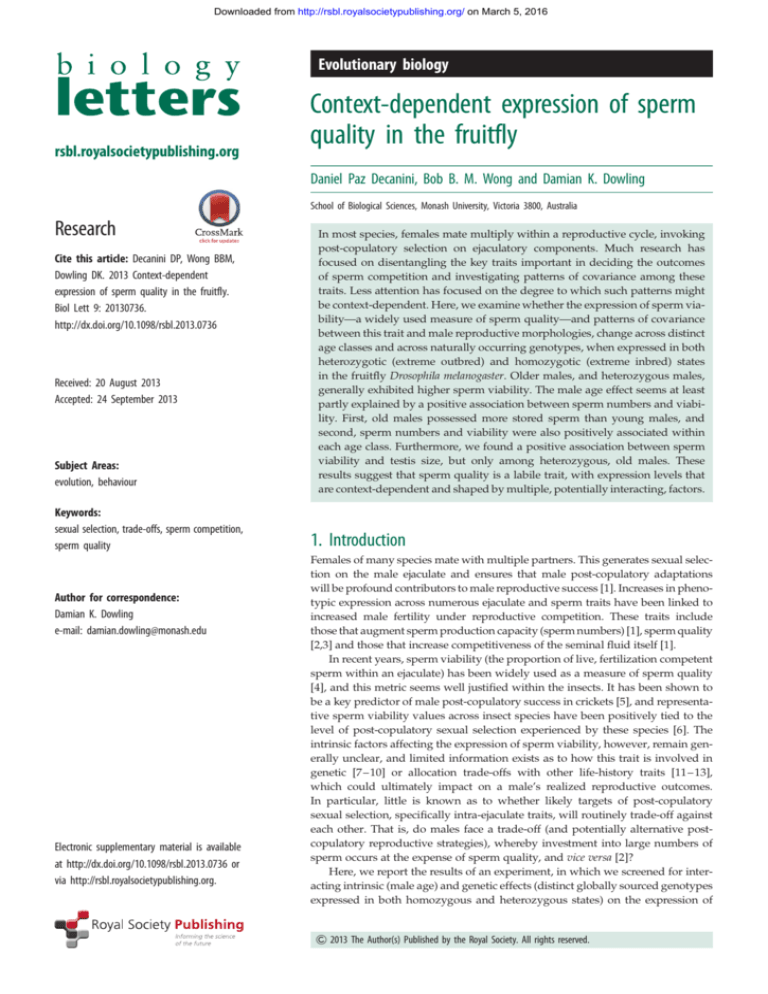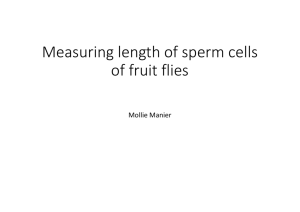
Downloaded from http://rsbl.royalsocietypublishing.org/ on March 5, 2016
Evolutionary biology
rsbl.royalsocietypublishing.org
Context-dependent expression of sperm
quality in the fruitfly
Daniel Paz Decanini, Bob B. M. Wong and Damian K. Dowling
School of Biological Sciences, Monash University, Victoria 3800, Australia
Research
Cite this article: Decanini DP, Wong BBM,
Dowling DK. 2013 Context-dependent
expression of sperm quality in the fruitfly.
Biol Lett 9: 20130736.
http://dx.doi.org/10.1098/rsbl.2013.0736
Received: 20 August 2013
Accepted: 24 September 2013
Subject Areas:
evolution, behaviour
Keywords:
sexual selection, trade-offs, sperm competition,
sperm quality
Author for correspondence:
Damian K. Dowling
e-mail: damian.dowling@monash.edu
Electronic supplementary material is available
at http://dx.doi.org/10.1098/rsbl.2013.0736 or
via http://rsbl.royalsocietypublishing.org.
In most species, females mate multiply within a reproductive cycle, invoking
post-copulatory selection on ejaculatory components. Much research has
focused on disentangling the key traits important in deciding the outcomes
of sperm competition and investigating patterns of covariance among these
traits. Less attention has focused on the degree to which such patterns might
be context-dependent. Here, we examine whether the expression of sperm viability—a widely used measure of sperm quality—and patterns of covariance
between this trait and male reproductive morphologies, change across distinct
age classes and across naturally occurring genotypes, when expressed in both
heterozygotic (extreme outbred) and homozygotic (extreme inbred) states
in the fruitfly Drosophila melanogaster. Older males, and heterozygous males,
generally exhibited higher sperm viability. The male age effect seems at least
partly explained by a positive association between sperm numbers and viability. First, old males possessed more stored sperm than young males, and
second, sperm numbers and viability were also positively associated within
each age class. Furthermore, we found a positive association between sperm
viability and testis size, but only among heterozygous, old males. These
results suggest that sperm quality is a labile trait, with expression levels that
are context-dependent and shaped by multiple, potentially interacting, factors.
1. Introduction
Females of many species mate with multiple partners. This generates sexual selection on the male ejaculate and ensures that male post-copulatory adaptations
will be profound contributors to male reproductive success [1]. Increases in phenotypic expression across numerous ejaculate and sperm traits have been linked to
increased male fertility under reproductive competition. These traits include
those that augment sperm production capacity (sperm numbers) [1], sperm quality
[2,3] and those that increase competitiveness of the seminal fluid itself [1].
In recent years, sperm viability (the proportion of live, fertilization competent
sperm within an ejaculate) has been widely used as a measure of sperm quality
[4], and this metric seems well justified within the insects. It has been shown to
be a key predictor of male post-copulatory success in crickets [5], and representative sperm viability values across insect species have been positively tied to the
level of post-copulatory sexual selection experienced by these species [6]. The
intrinsic factors affecting the expression of sperm viability, however, remain generally unclear, and limited information exists as to how this trait is involved in
genetic [7–10] or allocation trade-offs with other life-history traits [11–13],
which could ultimately impact on a male’s realized reproductive outcomes.
In particular, little is known as to whether likely targets of post-copulatory
sexual selection, specifically intra-ejaculate traits, will routinely trade-off against
each other. That is, do males face a trade-off (and potentially alternative postcopulatory reproductive strategies), whereby investment into large numbers of
sperm occurs at the expense of sperm quality, and vice versa [2]?
Here, we report the results of an experiment, in which we screened for interacting intrinsic (male age) and genetic effects (distinct globally sourced genotypes
expressed in both homozygous and heterozygous states) on the expression of
& 2013 The Author(s) Published by the Royal Society. All rights reserved.
Downloaded from http://rsbl.royalsocietypublishing.org/ on March 5, 2016
2. Material and methods
Table 1. Final models of the effects of reproductive traits, genetic strain,
genetic status and age, on sperm viability. SS, sum of squares.
source
SS
d.f.
F
p
2000
1
5.974
0.016
genetic strain
age
485
2286
3
1
0.483
6.826
0.695
0.010
sperm length
519
1
1.551
0.215
residuals
50 562
(b) young males model
151
Full methods are provided in the electronic supplementary
materials. The experiment harnessed five near-isogenic strains of
D. melanogaster—four derived from globally diverse wild populations (DAH, PUER, ZIM and MAD, denoted ‘wild-type’) and a
fifth (w 1118) from the Canton-S laboratory population.
The experiment was conducted in four temporal blocks.
Environmental sources of variation were controlled, including
maintaining egg numbers at a set density in vials that produced
the focal flies. In the parental generation, virgin males of each
wild-type strain were crossed either to virgin females of the same
strain (in eight pairs per replicate) to create a standard homozygous
focal male genotype per strain, or to virgin females from w 1118
(eight pairs per replicate) to create a standard heterozygous male
genotype per strain. In each block, we generated three replicate
crosses per wild-type strain, in each of the homozygous and heterozygous states (see electronic supplementary material, table S1).
Thus, we could measure the contribution of each of four distinct
genotypes in the context of both a diploid (i.e. two copies of each
autosomal gene derived from the focal genotype—genome-wide
homozygosity) and haploid (i.e. one copy of each autosomal gene
derived from the focal genotype—genome-wide heterozygosity)
states (see the electronic supplementary material, for motivation).
Ten days after these parental crosses, virgin males were collected
and stored in groups of eight, with each group assigned to an age
treatment. Males assigned to the young class were held in vials
for three days prior to dissection; males in the old class for 23
days. We measured sperm viability (Molecular Probes, Eugene,
OR, USA), testis and accessory gland areas, seminal vesicle area
and representative sperm head length from each dissected male.
Data were analysed using generalized linear models with
binomial errors and logit link, corrected for overdispersion in R
v. 2.11.1 [14]. The response variable was our measure of sperm
quality (live sperm and dead sperm). The expression of several
of the reproductive traits (total sperm, testis, accessory gland and
seminal vesicle areas, but not sperm length) varied markedly
across the two male age classes (see electronic supplementary
material, figure S1), and it was not possible to include these variables and age in the same analysis. Therefore, we fitted two sets
of models; first a model in which age (3, 24 days), genetic strain
(DAH, PUER, ZIM and MAD) and genetic status (homozygote
state and heterozygote state) were fitted as fixed factors and
sperm length as a covariate; then age-specific models (one for
young males and one for old), in which the reproductive morphological traits were fitted as covariates. In each analysis, full
models were progressively simplified, removing non-significant
parameters one at a time and comparing the models with F-tests.
within each age-class for sperm viability to increase with
increasing sperm numbers (table 1b,c and figure 1b,c).
Although males whose genotypes were expressed in a heterozygous state generally exhibited higher sperm viability
than their homozygous counterparts (table 1), this relationship
was strongly age-dependent and, furthermore, contingent on
testis size (table 1). Specifically, testis size was positively
associated with sperm viability, but only among old males
whose genotypes were expressed in a heterozygous state
(table 1c and figure 1d).
3. Results
4. Discussion
There were no significant differences in the expression of
sperm viability across the four genetic strains (table 1a–c).
The full model revealed that old males had higher sperm viability than young males (figure 1a). This pattern is, however,
probably attributable to old males storing larger numbers of
sperm than young males (see electronic supplementary
material, figure S1), because there was a clear association
The expression of sperm viability, and its association to the
reproductive morphologies investigated in our study, were
dependent both on the genetic status (i.e. whether the male’s
genotype was expressed in a homozygous or heterozygous
state) and the age of the focal males. We detected a contextdependent positive association between testis size and sperm
viability, which was only apparent in the cohort of old males
genetic status
genetic strain
2.9
602
1
3
0.0232
1.5815
0.880
0.205
accessory gland
area
76
1
0.5991
0.442
testis area
30.6
1
0.2411
0.625
18.4
463.3
1
1
0.1447
3.6514
0.705
0.061
1364.1
6598.2
1
52
10.7508
0.002
genetic status
genetic strain
2471.1
1219.0
1
3
5.9059
0.9711
0.018
0.411
accessory gland
area
1287.9
1
3.0782
0.083
testis area
sperm length
1191.5
454.7
1
1
2.8476
1.0867
0.096
0.301
seminal vesicle
236.8
1
0.5660
0.454
2376.0
2359.8
1
1
5.6786
5.6399
0.020
0.020
30 962.5
74
sperm length
seminal vesicle
total sperm
residuals
(c) old males model
total sperm
genetic status testicle area
residuals
Biol Lett 9: 20130736
(a) age-general model
genetic status
2
rsbl.royalsocietypublishing.org
sperm viability, in the fruitfly Drosophila melanogaster. As part
of the design, we screened for phenotypic covariance involving
ejaculate (stored sperm numbers and sperm length) and reproductive traits (testis, seminal vesicle and accessory gland size),
and their potential interactions with age and genetic effects, on
sperm viability.
Downloaded from http://rsbl.royalsocietypublishing.org/ on March 5, 2016
(a)
(b)
3
0.7
0.5
0.4
sperm viability
0.5
sperm viability
rsbl.royalsocietypublishing.org
0.6
0.6
0.4
0.3
0.3
0.2
Biol Lett 9: 20130736
0.1
0.2
0.1
0
old
young
1000
sperm numbers
500
age
(c)
(d)
homozygous
1500
heterozygous
0.50
0.8
0.45
0.7
0.40
sperm viability
sperm viability
0.6
0.35
0.30
0.25
0.5
0.4
0.3
0.2
0.20
0.1
0.15
0
2000
4000
6000
sperm numbers
8 0 2 4 6 8
8 0 2 4 6 8
0.0 0.1 0.1 0.1 0.1 0.1 0.0 0.1 0.1 0.1 0.1 0.1
testis size (mm2)
Figure 1. (a) Boxplots of proportion sperm viability across young and old males; (b,c) linear regression line and 95% confidence envelopes for the association
between sperm numbers extracted from the dissected seminal vesicle and sperm viability in (b) young and (c) old males; (d ) plot of interaction between
testis size and genetic status on sperm viability in old males. Dotted lines show 95% confidence envelopes.
whose genotypes were heterozygously expressed. Although
our study did not set out to test inbreeding effects, the effects
we found are consistent with the idea that the association
between testis size and sperm quality is eroded by inbreeding,
with old males exhibiting greater sensitivity to such effects (see
the electronic supplementary material for broader discussion
of this effect). Testing this would, however, require new experiments under a range of inbreeding coefficients typical of those
found in natural populations.
The age effects revealed in this study are worth critical
enquiry. Males of both young and old cohorts were kept as virgins until their dissection, and thus old males were storing
many more sperm—as reflected in their larger seminal vesicles
and greater sperm counts per vesicle (see electronic supplementary material, figure S1). Old males also possessed
larger accessory glands, responsible for producing the seminal proteins, but smaller testes (see electronic supplementary
material, figure S1), which suggests that their sperm
production capacity had decreased with age. Although old
males were storing sperm that was likely to be generally
older than those of their young counterparts, the viability of
these old sperm was around 75% higher than the sperm of
young males (see electronic supplementary material, figure
S1). This observation suggests that intra-ejaculate sperm numbers could well be the critical determinant of sperm viability,
rather than male age per se, with increases in sperm numbers
acting in some currently unknown way to protect the viability
of sperm [15]. This suggestion is strengthened greatly by the
finding of positive associations between sperm numbers and
viability within each age class. A broader implication of this
finding is that it suggests that males who mate less regularly
relative to their competitors will display superior fertility
under sperm competition once engaging in copulation. Ultimately, definitively disentangling which of male age or sperm
numbers is the primary driver of the sperm viability phenotype
would require a design in which the males of each age class are
Downloaded from http://rsbl.royalsocietypublishing.org/ on March 5, 2016
Data accessibility. Raw data are available in figshare: http://dx.doi.org/
10.6084/m9.figshare.805223 [19].
Funding statement. We thank the Australian Research Council for its
financial support (to D.K.D. and B.B.M.W.).
References
1.
2.
3.
4.
5.
6.
7.
Simmons LW. 2001 Sperm competition and its
evolutionary consequences in the insects. Princeton,
NJ: Princeton University Press.
Snook RR. 2005 Sperm in competition: not playing
by the numbers. Trends Ecol. Evol. 20, 46 –53.
(doi:10.1016/j.tree.2004.10.011)
Fitzpatrick JL, Garcı́a-González F, Evans JP. 2010
Linking sperm length and velocity: the importance
of intramale variation. Biol. Lett. 6, 797– 799.
(doi:10.1098/rsbl.2010.0231)
Holman L. 2009 Sperm viability staining in ecology
and evolution: potential pitfalls. Behav. Ecol.
Sociobiol. 63, 1679–1688. (doi:10.1007/s00265009-0816-4)
Garcı́a-González F, Simmons LW. 2005 Sperm
viability matters in insect sperm competition. Curr.
Biol. 15, 271 –275. (doi:10.1016/j.cub.2005.01.032)
Hunter FM, Birkhead TR. 2002 Sperm viability and
sperm competition in insects. Curr. Biol. 12,
121–123. (doi:10.1016/S0960-9822(01)00647-9)
Moore PJ, Harris WE, Montrose VT, Levin D,
Moore AJ. 2004 Constraints on evolution and
postcopulatory sexual selection: trade-offs among
ejaculate characteristics. Evolution 58, 1773– 1780.
(doi:10.1111/j.0014-3820.2004.tb00460.x)
8.
9.
10.
11.
12.
13.
Birkhead TR, Pellatt EJ, Brekke P, Yeates R,
Castillo-Juarez H. 2005 Genetic effects on sperm
design in the zebra finch. Nature 434, 383 –387.
(doi:10.1038/nature03374)
Dowling DK, Nowostawski AL, Arnqvist G. 2007
Effects of cytoplasmic genes on sperm viability and
sperm morphology in a seed beetle: implications for
sperm competition theory? J. Evol. Biol. 20,
358 –368. (doi:10.1111/j.1420-9101.2006.01189.x)
Simmons LW, Moore AJ. 2009 Evolutionary
quantitative genetics of sperm. In Sperm biology: an
evolutionary perspective (eds TR Birkhead,
DJ Hosken, S Pitnick), pp. 405 –434. London, UK:
Academic Press.
Simmons LW, Roberts B. 2005 Bacterial immunity
traded for sperm viability in male crickets. Science
309, 2031. (doi:10.1126/science.1114500)
Immler S, Pitnick S, Parker GA, Durrant KL, Lüpold S,
Calhim S, Birkhead TR. 2011 Resolving variation in the
reproductive tradeoff between sperm size and
number. Proc. Natl Acad. Sci. USA 108, 5325–5330.
(doi:10.1073/pnas.1009059108)
Dowling DK, Simmons LW. 2012 Ejaculate
economics: testing the effects of male sexual history
on the trade-off between sperm and immune
14.
15.
16.
17.
18.
19.
function in Australian crickets. PLoS ONE 7, e30172.
(doi:10.1371/journal.pone.0030172)
R Development Core Team. 2010 R: a language and
environment for statistical computing. Vienna,
Austria: R Foundation for Statistical Computing.
Holman L, Snook RR. 2008 A sterile sperm caste
protects brother fertile sperm from female-mediated
death in Drosophila pseudoobscura. Curr. Biol. 18,
292–296. (doi:10.1016/j.cub.2008.01.048)
Pitnick S. 1996 Investment in testes and the cost of
making long sperm in Drosophila. Am. Nat. 148,
57– 80. (doi:10.1086/285911)
Evans JP. 2011 Patterns of genetic variation and
covariation in ejaculate traits reveal potential
evolutionary constraints in guppies. Heredity 106,
869–875. (doi:10.1038/hdy.2010.130)
Gómez Montoto L, Magaña C, Tourmente M,
Martı́n-Coello J, Crespo C, Luque-Larena JJ,
Gomendio M, Roldan RS. 2011 Sperm competition,
sperm numbers and sperm quality in Muroid
rodents. PLoS ONE 6, e18173. (doi:10.1371/
journal.pone.0018173)
Dowling D, Decanini D. 2013 Context-dependent
expression of sperm quality in the fruitfly. figshare.
See http://dx.doi.org/10.6084/m9.figshare.805223.
4
Biol Lett 9: 20130736
homozygously or heterozygously. Thus, the current weight of
evidence indicates that post-copulatory sexual selection does
not regularly drive trade-offs between sperm numbers and
sperm quality [2,7,15,18]. Yet, evidence exists that production
of high-quality sperm nonetheless does routinely come at a
cost to males, by invoking trade-offs between investment in
sperm quality and in other life-history phases [11,13].
In sum, our results suggest that sperm viability—a widely
used measure of sperm quality and likely key determinant of
male fertility outcomes—is a dynamic trait, whose phenotypic
expression is context-dependent and potentially shaped by
numerous interacting factors and morphological associations.
rsbl.royalsocietypublishing.org
mated multiply and at different mating rates. That said, the
relationship described above, between testis size and sperm
viability in old and heterozygous males did indeed account
for confounding effects of sperm numbers—and this result
thus highlights dedicated male age effects on the expression
of sperm viability.
It has been suggested that intra-ejaculate traits will be subjected to allocation trade-offs [2]. While some studies support
this idea, showing trade-offs between sperm size and quantity/quality [13,16,17], evidence for trade-offs between sperm
quantity and quality have remained elusive, with growing
support for the suggestion that expression of these two intraejaculate traits is usually either unlinked [7] or otherwise
positively associated [15,18], as we report here. In our study,
this positive association was robust across distinct age classes
and genotypes regardless of whether they were expressed





